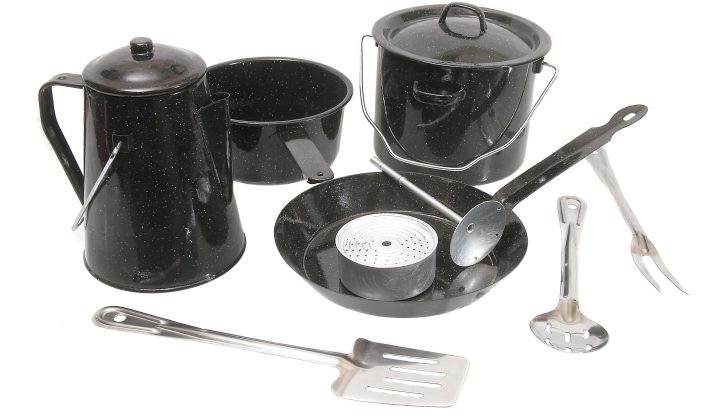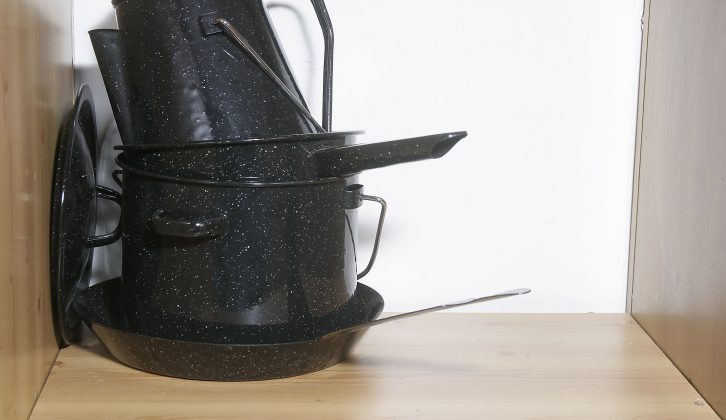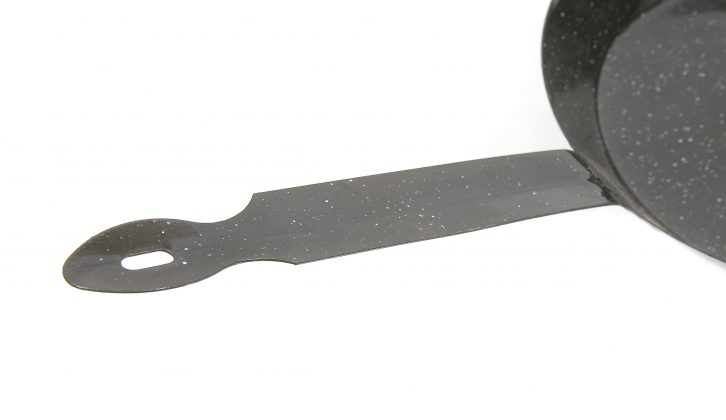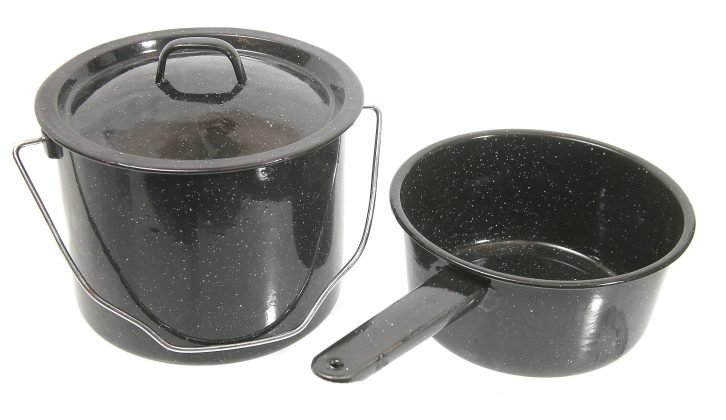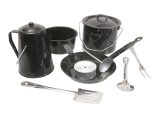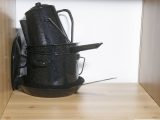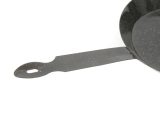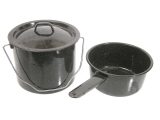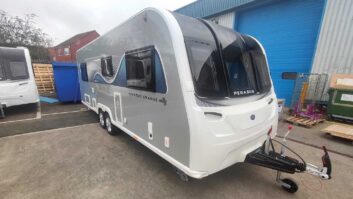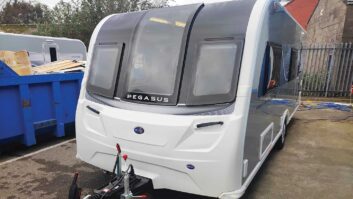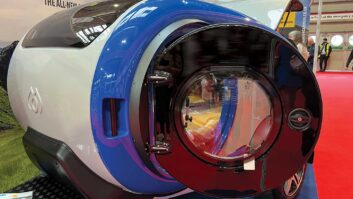Verdict
Getting the Coleman eight-piece enamelled cook set for £40 seems like a bargain, but we think it might be a case of quantity over quality. At least the saucepans are the right sizes, but this advantage alone won’t be enough to persuade us to get our fingers burnt.
Pros
Plenty of pieces in the set
Fair price
Good sizes
Cons
Metal handles get dangerously hot
Thin steel
One lid for two saucepans
Percolator pieces weren’t easy to assemble
The chances are, if we looked inside most caravans’ cupboards, we’d find that the majority of pots and pans are hand-me-downs from when the home kitchen had its last revamp. That’s a thrifty approach, but is it the best for your touring cuisine?
Well, probably not. We all know that storage space is at a premium in even the grandest of caravans, so cook sets that pack down small have a big advantage over bulky domestic pots and pans. This is particularly true if you take food seriously wherever you are, and need a lot of cookware with you.
Small is beautiful on the hob, too. After all, van hobs are smaller than domestic ones, so more compact pans come into their own when you’ve several on the go. Plus you’re more likely to be cooking for two, rather than four or five, so you won’t need such big pans.
We gathered together a selection of camping cookware sets on the Practical Caravan test bench for comparison – and you can read a selection of our cookware reviews here. We’ve tested the Coleman eight-piece enamelled cook set, costing £40, the Kampa Feast set of four at £33.99, the Outwell Gastro cook set M at £35.99, the Quest three-piece saucepan set at just £15, the Lakeland Ceramica four-piece nesting pan set at £94.99, and the Tefal Ingenio 13-piece set, costing a whopping £149.99.
How did we choose between them? We kicked off our review by counting how many pans each set contains, and then evaluated how well-suited to a caravan galley the contents are. Small to medium pans are more practical than large ones and, while enormous frying pans are a little impractical, so are tiny backpacking-issue ones that can’t accommodate an average-length sausage.
Next we checked out other touring credentials, such as each set’s total weight and how small they pack down. We had to factor in storage size against the number of pieces: a three-piece set is easier to store than a 10-piece. In addition, it’s clearly an advantage if a stored set doesn’t have handles that protrude into adjacent cupboard space.
Talking of handles, they should allow effortless grip of the pans to which they’re attached. And it almost goes without saying that some handles may become as hot as the pan’s contents – these are best avoided.
Much the same can be said for pan lids. Their handles should be easy to grip and must stay at a comfortable-to-hold temperature.
Lids themselves are another important factor. Ideally each set should have one per saucepan, simply because a covered pan boils so much more quickly and consequently uses much less gas. That’s always a consideration when you’re not hooked up to a mains gas supply.
Some pan sets are much more versatile than others. Pans that can be used for baking allow you to cut down on baking trays and the like. If a pan has detachable or foldable handles, it can also double as a serving dish. Some sets come with clip-on plastic lids so leftovers can be left in the pan and placed directly in the fridge without your needing special storage containers or resorting to aluminium foil or cling film to cover them.
But what are the pans like to use? Traditional thin camping cookware conducted heat so quickly that it was often impossible not to burn food. We prefer thicker walls, whether made from aluminium or stainless steel, which make leisure cookware feel much more like what we’re used to at home. Thicker walls, plus a lid, also ease timing when preparing a meal. Rather than boiling veg until it’s mushy, pans with decent heat retention allow your veg to stay warm even after the gas is turned off and the water is drained away.
Finally, although all pans here sport non- stick coatings, it’s best to deep-clean them when you return home. So compatibility with dishwashers is yet another desirable feature.
So, that’s the testing process. How, then, did the Coleman eight-piece enamelled cook set stand up under scrutiny?
Coleman has sized the three pans in this set perfectly. The saucepan and stock pot both have 18cm diameters and, at 24cm, the frying pan is the perfect trade off between being small enough to fit on a van hob and being a usable size.
In most other ways, though, this set misses it goals dramatically. The thin steel construction isn’t nice to cook with, and we certainly don’t like the — usually hot — metal handles. It’s annoying, too, that only a single lid is provided for both saucepans.
The bizarre kettle-cum-coffee pot would be better if it was clear how the percolator components fit together.
It’s annoying that only a single lid is provided for both saucepans
Technical Specifications
| Saucepan and stock pot size | 18cm diameter |
| Frying pan size | 24cm diameter |
| Coffee pot | Eight-cup size |
| Utensils | Long-handled stainless-steel spoon, fork and slotted spatula |
| Pan materials | Steel and crack-resistant, double-fired enamel |
| Colour | Black |
